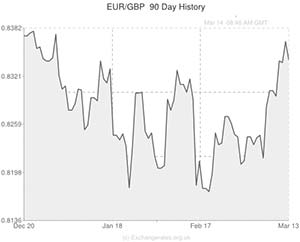
With the Euro supported by the European Central Bank’s decision to leave stimulus unaltered, the common currency has been putting in an impressive performance against the Pound this week.
During European trading on Friday the EUR/GBP pairing was fairly range bound, hovering close to the key psychological 1.20 Euros per Pound level.
Although the Euro softened against several of its major rivals after European Central Bank President Mario Draghi expressed the belief that the central bank’s forward guidance policy would help drive the common currency lower, it continued trading higher against the Pound.
While Euro strength is indicative of the Eurozone’s stabilising economic recovery, it is putting pressure on the nation’s exporters and adding to the currency bloc’s inflation pressures.
Bloomberg News recorded currency strategist Steven Englander responding to Draghi’s words in the following terms; ‘The only thing Draghi did not say was that the Euro is ‘brutally high’. There have been an ascending series of comments from ECB officials soft-circling the [Euro] as a concern’.
Final German inflation figures confirmed previous estimates and had little impact on the Euro, but Sterling came under pressure following the release of a less-than-impressive UK trade balance report.
The UK’s trade deficit widened in January due to good exports plunging 4 per cent to their lowest level for over 18 months.
The nation’s overall trade deficit widened from 668 million in December to 2.565 in January.
The goods deficit stood at 9.793 billion Pounds, up from 7.662 billion Pounds the previous month.
Meanwhile, Office for National Statistics data showed that UK construction output increased by 1.8 per cent in January month-on-month, down from growth of 2.0 per cent in December.
On the year construction output was up 5.4 per cent following a negatively revised increase of 4.9 per cent in December.
The news that the pace of construction output slowed by less-than-expected in January did little to prevent the Pound easing lower against its major currency counterparts.
Industry expert Paul Connolly said of the result; ‘The recovery is real, but dotted with caveats. Such mixed data neatly illustrate both the strengths and the weaknesses of the construction industry’s progress. The headline figures are impressive – with growth of 1.8% in January alone, total output is now half a billion pounds higher than it was at the same time last year. But much of this growth is heavily focused on house building. Outside the buoyant residential sector – which is up by a truly remarkable 35% in a year – things are much less encouraging. Infrastructure output sank by 2.3% in January and is 3.2% down on the same time last year. The regional picture remains patchy too.’
The Euro is likely to hold gains against the Pound into the weekend.
Next week the EUR/GBP pairing can be expected to experience more notable movement than has been seen in the last five days.
If Eurozone inflation data indicates that the ECB should have introduced stimulus this month the Euro could fall.
Meanwhile, recent UK PMI reports indicate that Britain enjoyed another month of strong jobs gains in February. If Thursday’s employment report confirms this the Pound could break through the 1.20 Euro per Pound level and could breach 1.21.
The EUR/USD pairing may fluctuate this afternoon following the publication of the US University of Michigan confidence gauge.
Euro Exchange Rates
[table width=”100%” colwidth=”50|50|50|50|50″ colalign=”left|left|left|left|left”]
Currency, ,Currency,Rate ,
Euro, ,Pound Sterling,0.8326
,Pound Sterling,0.8326
Euro, ,US Dollar,1.3891,
,US Dollar,1.3891,
Euro, ,Canadian Dollar,1.5431,
,Canadian Dollar,1.5431,
Euro, ,Australian Dollar,1.5346,
,Australian Dollar,1.5346,
Euro, ,New Zealand Dollar,1.6420 ,
,New Zealand Dollar,1.6420 ,
US Dollar, ,Euro ,0.7199,
,Euro ,0.7199,
Pound Sterling, ,Euro,1.2011,
,Euro,1.2011,
Canadian Dollar, ,Euro,0.6478,
,Euro,0.6478,
Australian Dollar, ,Euro,0.6514,
,Euro,0.6514,
New Zealand Dollar, ,Euro,0.6096 ,
,Euro,0.6096 ,
[/table]

Comments are closed.